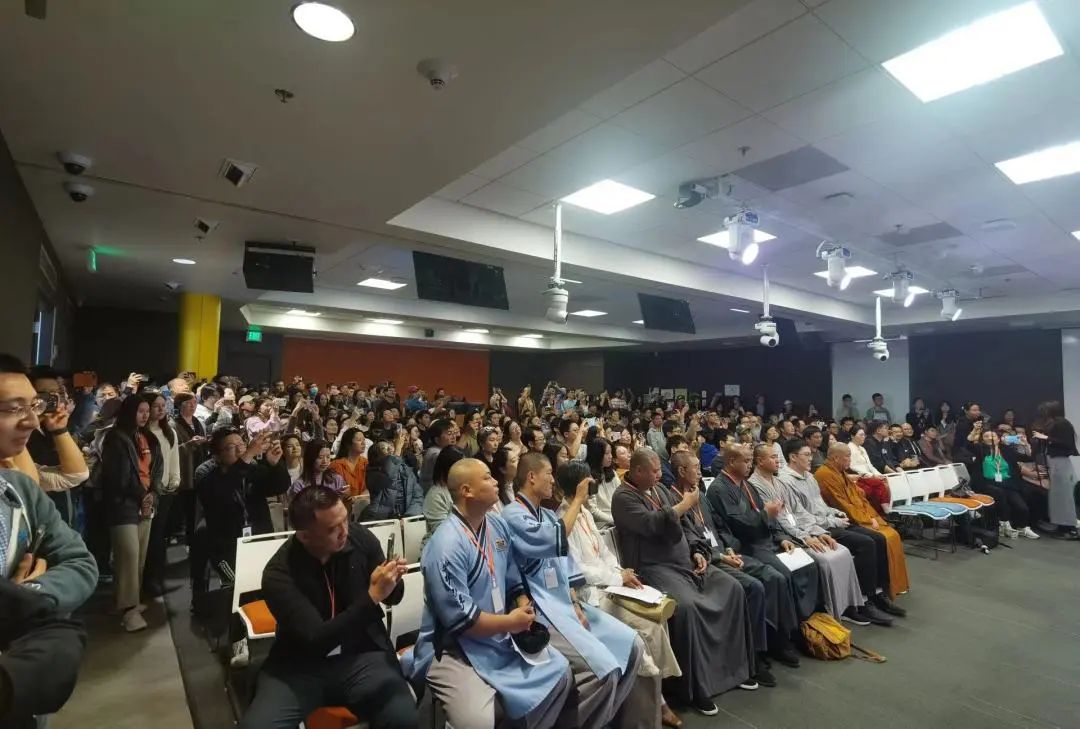禅宗遇到AI——在美国旧金山Meta公司总部交流会上的讲话
◎释永信大和尚 少林寺官方网站 2023-11-03 01:21 Posted on 河南
尊敬的各位来宾和朋友:
大家好!
今天非常荣幸能同各位朋友分享“禅宗遇到AI”这个话题。随着人工智能技术的不断发展,它正在逐渐渗透到我 们生活的各个领域。与此同时,这种技术的普及也对传统信仰产生了巨大影响。当古老的东方禅宗思想遇到21世 纪尖端技术的人工智能,人文与科技的交汇势必会给当今世界的人们带来新的启示。



释永信方丈2023年11月2日于旧金山Meta公司总部
佛教到今天已经有2500余年的发展历史。禅宗是中国佛教影响最大、传播最广、发展最成熟的宗派,其中心思 想可概括为“不立文字,教外别传,直指人心,见性成佛”。禅宗追求心灵的觉悟,它是对佛陀思想的继承和创新 ,同时又融汇了中国传统的儒家、道家思想,其修行方法以真修实证为主,不受任何知识、逻辑、思维乃至意识所 束缚,是修禅者对解脱智慧的流露。禅宗思想深刻影响了中国的哲学、文学、艺术等领域,同时也在服务社会、净 化人心、开启心智等方面做出了积极贡献。
少林寺始建于公元495年,禅宗初祖菩提达摩在少林寺面壁九年创立禅宗。少林寺作为禅宗祖庭,1500多年 来传承不断,其主要以“禅”为核心,以养生、功夫、医药和禅艺等为表现形式,方便度化众生。少林养生功法以 习练《易筋经》等气功为主,辅以素食、坐禅、经行等方法,以达到涵养精气神之妙用。少林功夫是中国首批非物 质文化遗产,以佛教信仰和禅宗智慧为基础,具有完整的技击理论体系,形成有擒拿、格斗、卸骨、点穴、拳械等 多种功法,并形成了标准化、规范化的少林功夫段品制的修学体系,其最高境界为“禅武合一”。少林医药来自对 佛学“医方明”的继承,结合中国传统中医,主张运用佛法治心、草本治身,以达到调养身心之功效。少林禅艺则 以绘画、书法、雕刻、梵呗、茶器及围棋等为载体,以艺入禅来传播禅宗文化。
少林文化通过不断的传承与交流,已在韩国、日本、东南亚等地区得到广泛传播,近几十年来,欧美各国也涌现出 许多少林文化的爱好者。少林寺还积极参与国际交流活动,为服务人类健康做出了积极贡献。目前,少林寺在全世 界150多个国家200多个地区都有少林文化交流中心。
少林寺在历史发展中几经兴衰,但是如今依然传承不断,其原因在于少林文化的内动力,它兼容并蓄,并且提倡人 与自然,人与社会,人与自身的和合共生,同时少林文化在沟通国际关系、推动世界和平方面发挥了积极作用。少 林寺在未来也依然会坚持传播平等、慈悲、清净、圆融的佛教普世价值观,更好的服务全人类。
当禅宗遇到人工智能时会发生什么?技术进步能否取代道德伦理进步?人工智能具有强大的数据处理和分析能力, 并且经由程序和算法可能会表现出类似于人类的感知,但是人工智能并不能具备我们禅宗所讲的觉悟的心性。人类 面对此人工智能应该保持头脑清醒,应该如禅宗所倡导的那样向内寻求,得到超越解脱的本觉智慧。
禅宗是强调修禅者通过自身的精进和努力,逐渐提升觉悟的境界,在这个过程中,常常会遇到诸多困惑和烦恼,A I作为一作工具,可以检索查找相关经典,从而对治各种疑惑,为修禅者提供辅助和便利。
科技的进步让人们的闲暇时间增多,我们不希望因为闲暇时间的增多而使大众变得懒散放逸。在未来,我希望禅宗 智慧和人工智能可以有更多互动,特别是在少林文化方面,能够携手搭建一个交流平台,让大众在修学体验少林禅 、武、医、艺文化时,能够更加身临其境地感受少林文化的独特魅力,追求精神上的圆满,也让少林文化更好地服 务全人类身心灵健康。
最后,祝愿大家一切吉祥!阿弥陀佛。
Yongxin Shi Transcript
English Version:
"Zen Buddhism Encounters AI"
Respected guests and friends:
Greetings to all!
Today, I am truly honored to share the topic "Zen Buddhism Encounters AI" with all of you. With the continuous advancement of artificial intelligence technology, it is gradually permeating every area of our lives. At the same time, the widespread adoption of this technology has significantly impacted traditional beliefs. When the ancient Eastern Zen thought encounters the cutting-edge AI technology of the 21st century, the intersection of humanities and technology is bound to offer new insights for people today.
Buddhism has a development history spanning over 2,500 years. Zen Buddhism is the most influential, widely spread, and mature school within Chinese Buddhism. Its core philosophy can be summarized as "not reliant on scriptures, teachings passed beyond words, directly pointing to the human heart, and achieving enlightenment upon recognizing one's nature." Zen seeks spiritual awakening. It inherits and innovates upon the teachings of the Buddha and integrates with traditional Chinese Confucian and Taoist philosophies. Its practice primarily emphasizes genuine cultivation and validation, unbounded by any knowledge, logic, thinking, or even consciousness, and is a manifestation of enlightenment wisdom. Zen thought profoundly influences Chinese philosophy, literature, and art, actively contributing to societal service, purifying the heart, and enlightening the mind.
The Shaolin Temple, founded in AD 495, is where the first Zen patriarch, Bodhidharma, founded Zen after meditating facing a wall for nine years. As the cradle of Zen Buddhism, the Shaolin Temple has been continuously passing down its teachings for over 1,500 years, with its core being Zen, and expressed in forms of health preservation, martial arts, medicine, and Zen arts. The health preservation methods of Shaolin primarily involve practicing qigong exercises like "Yijin Jing," supplemented with vegetarianism, meditation, and sutra recitation to nurture the essence, energy, and spirit. Shaolin Kung Fu, one of China's first intangible cultural heritages, is based on Buddhist beliefs and Zen wisdom. It possesses a complete theoretical system of combat techniques, consisting of grappling, fighting, bone-breaking, pressure point strikes, and various weapon techniques, all structured into a standardized system of progression. The ultimate realm of Shaolin martial arts is the unification of "Zen and Martial Arts." Shaolin medicine derives from the Buddhist concept of "Understanding Medicinal Properties," integrated with traditional Chinese medicine, advocating for healing the mind through Buddhist teachings and the body through herbal remedies. Shaolin Zen arts encompass painting, calligraphy, sculpture, chanting, tea ceremonies, and Go (the board game), serving as vehicles to promote Zen culture.
Shaolin culture, through continuous inheritance and exchange, has been widely disseminated in regions like South Korea, Japan, and Southeast Asia. In recent decades, many enthusiasts of Shaolin culture have also emerged in European and American countries. The Shaolin Temple actively participates in international exchanges, making positive contributions to human health. Currently, there are Shaolin cultural exchange centers in over 200 regions across 150 countries worldwide.
The Shaolin Temple has experienced highs and lows throughout its history, but its enduring legacy is due to the inner vitality of Shaolin culture. It emphasizes harmony between humans and nature, society, and oneself. Moreover, Shaolin culture plays a pivotal role in fostering international relations and promoting world peace. In the future, the temple will continue to propagate the universal Buddhist values of equality, compassion, purity, and integration, better serving humanity.
So, what happens when Zen meets AI? Can technological progress replace moral and ethical advancement? AI possesses a tremendous capability for data processing and analysis, and through programming and algorithms, it might exhibit human-like perceptions. However, AI cannot possess the awakening and consciousness preached by Zen. In the face of AI, humans should maintain clarity of mind and seek inner enlightenment and transcendental wisdom, as advocated by Zen.
Zen emphasizes that practitioners elevate their state of enlightenment through dedication and effort. In this process, they often encounter various confusions and troubles. AI, as a tool, can assist by searching relevant scriptures, thereby addressing doubts and providing support and convenience for practitioners.
Technological advancement has granted people more leisure time. We hope that this won't make the masses lax and indulgent. In the future, I wish for more interactions between Zen wisdom and AI, especially in the context of Shaolin culture. Together, they can build a platform for communication, allowing the public to immerse themselves in experiencing the culture of Shaolin's Zen, martial arts, medicine, and arts. This will enable them to feel the unique charm of Shaolin culture more vividly, pursuing spiritual fulfillment and allowing Shaolin culture to better serve the physical and mental well-being of all humanity.
In conclusion, I wish everyone all the best and happiness! Amitabha Buddha.




 Reply With Quote
Reply With Quote










